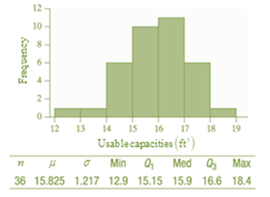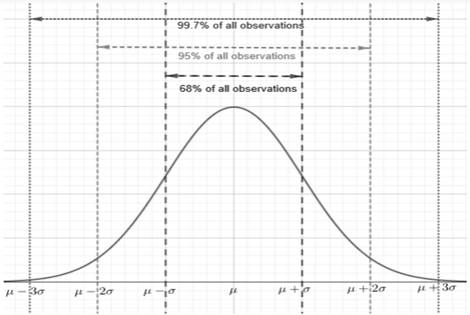
Concept explainers
Whether the distribution of refrigerator capacities approximately normal.
Answer to Problem 75E
The distribution of refrigerator capacities is approximately normal.
Explanation of Solution
Given information:

According to 68 − 95 − 99.7 rule:
68% of the data of a
95% of the data of a normal distribution lies with 2 standard deviation from the mean.
99.7% of the data of a normal distribution lies with 1 standard deviation from the mean.
Then
The general Normal density graph is represented as:

Note that
The sample has 24 out of 36 observations within 1 standard deviation of the mean.
That means
The sample has 66.67% observations within 1 standard deviation.
Between
And
Also note that
The sample has 34 out of 36 observations within 2 standard deviation of the mean.
That means
The sample has 94.44% observations within 2 standard deviation.
Between
And
Also note that
The sample has 36 out of 36 observations within 3 standard deviation of the mean.
That means
The sample has 100% observations within 3 standard deviation.
Between
And
We have that
66.67% is very close to 68%.
94.44% is very close to 95%.
100% is very close to 99.7%.
This implies
The data reasonably follows 68 − 95 − 99.7 rule.
Thus,
The distribution is approximately normal.
Chapter 2 Solutions
PRACTICE OF STATISTICS F/AP EXAM
Additional Math Textbook Solutions
Elementary Statistics (13th Edition)
Basic Business Statistics, Student Value Edition
Elementary Statistics: Picturing the World (6th Edition)
Elementary Statistics Using Excel (6th Edition)
Statistics: The Art and Science of Learning from Data (4th Edition)
 MATLAB: An Introduction with ApplicationsStatisticsISBN:9781119256830Author:Amos GilatPublisher:John Wiley & Sons Inc
MATLAB: An Introduction with ApplicationsStatisticsISBN:9781119256830Author:Amos GilatPublisher:John Wiley & Sons Inc Probability and Statistics for Engineering and th...StatisticsISBN:9781305251809Author:Jay L. DevorePublisher:Cengage Learning
Probability and Statistics for Engineering and th...StatisticsISBN:9781305251809Author:Jay L. DevorePublisher:Cengage Learning Statistics for The Behavioral Sciences (MindTap C...StatisticsISBN:9781305504912Author:Frederick J Gravetter, Larry B. WallnauPublisher:Cengage Learning
Statistics for The Behavioral Sciences (MindTap C...StatisticsISBN:9781305504912Author:Frederick J Gravetter, Larry B. WallnauPublisher:Cengage Learning Elementary Statistics: Picturing the World (7th E...StatisticsISBN:9780134683416Author:Ron Larson, Betsy FarberPublisher:PEARSON
Elementary Statistics: Picturing the World (7th E...StatisticsISBN:9780134683416Author:Ron Larson, Betsy FarberPublisher:PEARSON The Basic Practice of StatisticsStatisticsISBN:9781319042578Author:David S. Moore, William I. Notz, Michael A. FlignerPublisher:W. H. Freeman
The Basic Practice of StatisticsStatisticsISBN:9781319042578Author:David S. Moore, William I. Notz, Michael A. FlignerPublisher:W. H. Freeman Introduction to the Practice of StatisticsStatisticsISBN:9781319013387Author:David S. Moore, George P. McCabe, Bruce A. CraigPublisher:W. H. Freeman
Introduction to the Practice of StatisticsStatisticsISBN:9781319013387Author:David S. Moore, George P. McCabe, Bruce A. CraigPublisher:W. H. Freeman





